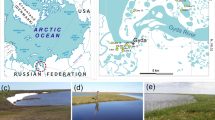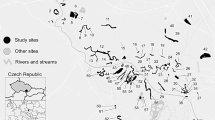Abstract
The aim of the present contribution is to assess whether the abundance of mollusk species in the Southern Pampas (Argentina), an environmentally homogeneous region, reflect the local conditions of water bodies. In order to test this hypothesis, a comprehensive study was conducted in 30 sites regularly distributed across the region. At each site, the abundance of mollusk species was determined, and a series of physico-chemical measurements taken. Principal Component Analysis (PCA) and Cluster Analysis (CA) were used for the ordination of sampling sites based on the measured environmental variables. In addition, Canonical Correspondence Analysis (CCA) was conducted to explore the relationships between environmental variables and mollusk abundances. Mollusk species were represented by the gastropods Biomphalaria peregrina, Chilina parchappii, Heleobia parchappii, Physa acuta, Pomacea canaliculata, Stenophysa marmorata, Uncancylus concentricus and the bivalve Musculium argentinum. Although aquatic vegetation cover, conductivity, and substrate were among the main parameters influencing mollusk distribution, their effect was insufficient to explain the spatial distribution pattern of the species in a regional scale. It is because the Southern Pampas is a very homogeneous area, and the ranges of these environmental conditions are within the range of ecological tolerance of most of the species represented. Yet, some species resulted good indicators of environmental conditions at local (microhabitat) scale, i.e., particular microhabitats that occur in different water bodies as well. In fact, even distributed in many different water bodies along the Southern Pampas C. parchappii is always linked to lotic environments, and U. concentricus is exclusively restricted to hard substrata. On the other hand, H. parchappii is the only species represented in mesohaline waters and P. acuta appeared to be a good indicator of pollution in the area.




Similar content being viewed by others
References
APHA, 1992. Standard Methods for the Examination of Water and Wastewater. APHA, Washington, DC.
Bocard, D., P. Legendre & P. Drapeau, 1992. Partialling out the spatial component of ecological variation. Ecology 73: 1045–1055.
Ciocco, N. F. & E. E. Scheibler, 2008. Malacofauna of the littoral benthos of a saline lake in southern Mendoza, Argentina. Fundamental and Applied Limnology 172: 87–98.
de Castellanos, Z. A. & D. Fernández, 1976. Mollusca, Gasteropoda, Ampullariidae. In Ringuelet R. A. (dir), Fauna de Agua Dulce de la República Argentina. Fundación para la Educación, la Ciencia y la Cultura, Buenos Aires 15: 1–33.
de Castellanos, Z. A. & M. C. Gaillard, 1981. Mollusca, Gasteropoda, Chilinidae. In Ringuelet R. A. (dir), Fauna de Agua Dulce de la República Argentina. Fundación para la Educación, la Ciencia y la Cultura, Buenos Aires 15: 19–52.
de Castellanos, Z. A. & N. Landoni, 1995. Mollusca Pelecypoda y Gasteropoda. In Lopretto, E. & G. Tell (eds), Ecosistemas de Aguas Continentales. Ediciones Sur, La Plata: 759–781.
De Francesco, C. G., 2007. Las limitaciones a la identificación de especies de Heleobia Stimpson, 1865 (Gastropoda: Rissooidea) en el registro fósil del Cuatenario tardío y sus implicancias paleoambientales. Ameghiniana 44: 631–635.
De Francesco, C. G. & G. S. Hassan, 2009. The significance of mollusks as paleoecological indicators of freshwater systems in Central-Western, Argentina. Palaeogeography, Palaeoclimatology, Palaeoecology 274: 105–113.
De Francesco, C. G. & F. I. Isla, 2004. Reproductive period and growth rate of the freshwater snail Heleobia parchappii (d′Orbigny, 1835) (Gastropoda, Rissooidea) in a shallow brackish habitat (Buenos Aires Province, Argentina). Malacologia 45: 443–450.
del Río, C. J., H. H. Camacho, M. Aguirre, A. Caramés, G. Cusmisnky, C. G. De Francesco, E. Farinati, S. Gordillo, C. Laprida, S. Miquel & S. Morton, 2007. Invertebrados del Cenozoico de la Argentina. Publicación Especial Ameghiniana 50º aniversario: 221–235.
Dillon, R. T. Jr., 2000. The Ecology of Freshwater Molluscs. Cambridge University Press, Cambridge.
Estebenet, A. L., P. R. Martín & S. Burela, 2006. Conchological variation in Pomacea canaliculata and other South American Ampullariidae (Caenogastropoda, Architaenioglossa). Biocell 30: 329–335.
Feijoó, C. S. & R. J. Lombardo, 2007. Baseline water quality and macrophyte assemblages in Pampean streams: a regional approach. Water Research 41: 1399–1410.
Fernández, D., 1981a. Mollusca, Gasteropoda, Physidae. In Ringuelet R. A. (dir), Fauna de agua dulce de la República Argentina. Fundación para la Educación, la Ciencia y la Cultura, Buenos Aires 15: 83–98.
Fernández, D., 1981b. Mollusca, Gasteropoda, Ancylidae. In Ringuelet R. A. (dir), Fauna de Agua Dulce de la República Argentina Fundación para la Educación, la Ciencia y la Cultura, Buenos Aires 15: 99–114.
Folk, R. L., 1968. Petrology of Sedimentary Rocks. University of texas at Hemphills, Austin.
Gaillard, M. C. & Z. A. de Castellanos, 1976. Mollusca, Gasteropoda, Hydrobiidae. In Ringuelet, R. A. (dir), Fauna de agua dulce de la República Argentina. Fundación para la Educación, la Ciencia y la Cultura, Buenos Aires 15: 1–40.
Hammer, Ø., D. A. T. Harper & P. D. Ryan, 2008. PAST—PAlaeontological STatistics, ver.1.81. http://folk.uio.no/ohammer/past.
Heiri, O., A. F. Lotter & G. Lemcke, 2001. Loss on ignition as a method for estimating organic and carbonate content in sediments: reproducibility and comparability of results. Journal of Paleolimnology 25: 101–110.
Martín, P. R., 1989. Microdistribución de los moluscos del arroyo Napostá Grande. Actas del primer Congreso Latinoamericano de Ecología. Montevideo, Uruguay.
Martín, P. R., 1998. Estudios ecológicos sobre los gasterópodos del arroyo Napostá Grande. Doctoral Thesis, Universidad Nacional del Sur.
Martín, P. R., A. L. Estebenet & N. J. Cazzaniga, 2001. Factors affecting the distribution of Pomacea canaliculata (Gastropoda: Ampullariidae) along its southernmost natural limit. Malacologia 43: 13–23.
Mouthon, J., 1996. Molluscs and biodegradable pollution in rivers: proposal for a scale in sensitivity of species. Hydrobiologia 317: 221–229.
Peretti, V., 2005. Factores ambientales y distribución de moluscos en las lagunas del centro-este de La Pampa. Graduate Thesis, Universidad Nacional de La Pampa, Santa Rosa, Argentina.
Quirós, R. & E. Drago, 1999. The environmental state of Argentinean lakes: an overview. Lakes and Reservoirs: Research and Management 4: 55–64.
Rumi, A., 1986. Estudio morfológico, taxonómico y bio-ecológico de planórbidos argentinos. Doctoral Thesis. Universidad Nacional de La Plata, La Plata, Argentina.
Rumi, A., 1991. La familia Planorbidae Rafinisque, 1815 en la República Argentina. In de Castellanos, Z. A. (ed.), Fauna de Agua Dulce de la República Argentina. Programa de Fauna de Agua Dulce Museo de La Plata, Buenos Aires 15: 3–51.
ter Braak, C. J. F. & P. Šmilauer, 1998. CANOCO Reference Manual and User’s Guide to CANOCO for Windows: Software for Canonical Community. Microcomputer Power, Ithaca, NY.
Tietze, E. & C. G. De Francesco, 2008. Distribución de moluscos en ambientes dulceacuícolas de la Pampa Interserrana (provincia de Buenos Aires). III Congreso Argentino de Conservación de la Biodiversidad (11–14 Agosto, Buenos Aires, Argentina): 352.
Van Schayck, I. R. C. P., 1985. Laboratory studies on the relation between aquatic vegetation and the presence of two Bilharzia-bearing snail species. Journal of Aquatic Plant Management 23: 87–91.
Acknowledgments
This research is part of the doctoral thesis of E. Tietze at the University of Mar del Plata. Financial support for this study was provided by Agencia Nacional de Promoción Científica y Tecnológica (PICT 16-20706). We gratefully acknowledge Verónica Núñez for helpful comments about physiid snails and Gabriela Hassan for her assistance with statistical analyses. We thank Christian Ituarte for helping us with the taxonomic identification of Musculium argentinum and Gustavo Bernava for chemical analyses. Néstor Ciocco and an anonymous reviewer improved the manuscript with constructive reviews. E. Tietze was funded by the National Council of Scientific and Technical Research of Argentina (CONICET) through a fellowship. Claudio De Francesco is a member of the Scientific Research Career of CONICET.
Author information
Authors and Affiliations
Corresponding author
Additional information
Handling editors: J. Saros & L. Naselli-Flores
Rights and permissions
About this article
Cite this article
Tietze, E., De Francesco, C.G. Environmental significance of freshwater mollusks in the Southern Pampas, Argentina: to what detail can local environments be inferred from mollusk composition?. Hydrobiologia 641, 133–143 (2010). https://doi.org/10.1007/s10750-009-0072-7
Received:
Revised:
Accepted:
Published:
Issue Date:
DOI: https://doi.org/10.1007/s10750-009-0072-7




